Rainfall Area Identification Algorithm Based on Himawari-8 Satellite Data and Analysis of its Spatiotemporal Characteristics
Abstract
1. Introduction
2. Materials and Methods
2.1. Materials
2.1.1. Himawari-8/AHI Data
2.1.2. GPM Data
2.1.3. CloudSat Data
2.1.4. China New Generation Weather Radar (CINRAD)
2.2. Methods
2.2.1. Selection of Algorithm Indicators
2.2.2. Determination of Threshold Criteria
2.2.3. Validation Method
2.2.4. Analysis of Rainfall Characteristics of Cloud Types
3. Results
3.1. Evaluation of Rainfall Area Algorithm Results
3.2. Analysis of Cloud Types in Rainfall Area
3.3. Spatiotemporal Characteristics Analysis of Rainfall Area
4. Discussion and Conclusions
Author Contributions
Funding
Data Availability Statement
Acknowledgments
Conflicts of Interest
References
- Bruintjes, R.T. A Review of Cloud Seeding Experiments to Enhance Precipitation and Some New Prospects. Bull. Am. Meteor. Soc. 1999, 80, 805–820. [Google Scholar] [CrossRef]
- Kulkarni, J.R.; Maheskumar, R.S.; Morwal, S.B. The Cloud Aerosol Interaction and Precipitation Enhancement Experiment (CAIPEEX): Overview and Preliminary Results. Curr. Sci. 2012, 102, 413–425. [Google Scholar]
- Kollias, P.; Clothiaux, E.E.; Miller, M.A.; Albrecht, B.A.; Stephens, G.L.; Ackerman, T.P. Millimeter-Wavelength Radars: New Frontier in Atmospheric Cloud and Precipitation Research. Bull. Am. Meteor. Soc. 2007, 88, 1608–1624. [Google Scholar] [CrossRef]
- Li, J.; Wang, W.-C.; Dong, X.; Mao, J. Cloud-Radiation-Precipitation Associations over the Asian Monsoon Region: An Observational Analysis. Clim. Dyn. 2017, 49, 3237–3255. [Google Scholar] [CrossRef]
- Liu, L.; Zheng, J.; Ruan, Z.; Cui, Z.; Hu, Z.; Wu, S.; Dai, G.; Wu, Y. Comprehensive Radar Observations of Clouds and Precipitation over the Tibetan Plateau and Preliminary Analysis of Cloud Properties. J. Meteorol. Res. 2015, 29, 546–561. [Google Scholar] [CrossRef]
- Zhang, J.; Chen, Y. Typhoon Nida’s Rainfall Characteristics in Guangzhou City Based on Doppler Radar Estimation. IOP Conf. Ser. Earth Environ. Sci. 2018, 169, 012002. [Google Scholar] [CrossRef]
- Lo, S.-W.; Wu, J.-H.; Lin, F.-P.; Hsu, C.-H. Cyber Surveillance for Flood Disasters. Sensors 2015, 15, 2369–2387. [Google Scholar] [CrossRef]
- Marzano, F.S.; Palmacci, M.; Cimini, D.; Giuliani, G.; Turk, F.J. Multivariate Statistical Integration of Satellite Infrared and Microwave Radiometric Measurements for Rainfall Retrieval at the Geostationary Scale. IEEE Trans. Geosci. Remote Sens. 2004, 42, 1018–1032. [Google Scholar] [CrossRef]
- Hossain, F.; Anagnostou, E.N. Assessment of Current Passive-microwave- and Infrared-based Satellite Rainfall Remote Sensing for Flood Prediction. J. Geophys. Res. 2004, 109, JD003986. [Google Scholar] [CrossRef]
- Kim, M.-S.; Kwon, B. Rainfall Detection and Rainfall Rate Estimation Using Microwave Attenuation. Atmosphere 2018, 9, 287. [Google Scholar] [CrossRef]
- Ma, Z.; Zhou, Y.; Hu, B.; Liang, Z.; Shi, Z. Downscaling Annual Precipitation with TMPA and Land Surface Characteristics in China. Int. J. Climatol. 2017, 37, 5107–5119. [Google Scholar] [CrossRef]
- Ji, D.; Shi, J.; Letu, H.; Li, W.; Zhang, H.; Shang, H. A Total Precipitable Water Product and Its Trend Analysis in Recent Years Based on Passive Microwave Radiometers. IEEE J. Sel. Top. Appl. Earth Obs. Remote Sens. 2021, 14, 7324–7335. [Google Scholar] [CrossRef]
- Min, M.; Bai, C.; Guo, J.; Sun, F.; Liu, C.; Wang, F.; Xu, H.; Tang, S.; Li, B.; Di, D.; et al. Estimating Summertime Precipitation from Himawari-8 and Global Forecast System Based on Machine Learning. IEEE Trans. Geosci. Remote Sens. 2019, 57, 2557–2570. [Google Scholar] [CrossRef]
- Yang, X.; Fei, J.; Huang, X.; Cheng, X.; Carvalho, L.M.V.; He, H. Characteristics of Mesoscale Convective Systems over China and Its Vicinity Using Geostationary Satellite FY2. J. Clim. 2015, 28, 4890–4907. [Google Scholar] [CrossRef]
- Allan, R.P.; Soden, B.J. Atmospheric Warming and the Amplification of Precipitation Extremes. Science 2008, 321, 1481–1484. [Google Scholar] [CrossRef]
- Roca, R.; Fiolleau, T. Extreme Precipitation in the Tropics Is Closely Associated with Long-Lived Convective Systems. Commun. Earth Environ. 2020, 1, 18. [Google Scholar] [CrossRef]
- Maddox, R.A. Mesoscale Convective Complexes. In Bulletin of the American Meteorological Society; American Meteorological Society: Boston, MA, USA, 2021; Volume 61. [Google Scholar]
- Williams, M.; Houze, R.A. Satellite-Observed Characteristics of Winter Monsoon Cloud Clusters. Mon. Weather Rev. 1987, 115, 505–519. [Google Scholar] [CrossRef]
- Falkovich, G.; Fouxon, A.; Stepanov, M.G. Acceleration of Rain Initiation by Cloud Turbulence. Nature 2002, 419, 151–154. [Google Scholar] [CrossRef] [PubMed]
- Lazri, M.; Ameur, S.; Brucker, J.M.; Testud, J.; Hamadache, B.; Hameg, S.; Ouallouche, F.; Mohia, Y. Identification of Raining Clouds Using a Method Based on Optical and Microphysical Cloud Properties from Meteosat Second Generation Daytime and Nighttime Data. Appl. Water Sci. 2013, 3, 1–11. [Google Scholar] [CrossRef]
- Nauss, T.; Kokhanovsky, A.A. Discriminating Raining from Non-Raining Clouds at Mid-Latitudes Using Multispectral Satellite Data. Atmos. Chem. Phys. 2006, 6, 5031–5036. [Google Scholar] [CrossRef]
- Martins, J.V.; Marshak, A.; Remer, L.A.; Rosenfeld, D.; Kaufman, Y.J.; Fernandez-Borda, R.; Koren, I.; Correia, A.L.; Zubko, V.; Artaxo, P. Remote Sensing the Vertical Profile of Cloud Droplet Effective Radius, Thermodynamic Phase, and Temperature. Atmos. Chem. Phys. 2011, 11, 9485–9501. [Google Scholar] [CrossRef]
- Tana, G. Retrieval of Cloud Microphysical Properties from Himawari-8/AHI Infrared Channels and Its Application in Surface Shortwave Downward Radiation Estimation in the Sun Glint Region. Remote Sens. Environ. 2023, 290, 113548. [Google Scholar] [CrossRef]
- Letu, H.; Ma, R.; Nakajima, T.Y.; Shi, C.; Hashimoto, M.; Nagao, T.M.; Baran, A.J.; Nakajima, T.; Xu, J.; Wang, T.; et al. Surface Solar Radiation Compositions Observed from Himawari-8/9 and Fengyun-4 Series. Bull. Am. Meteorol. Soc. 2023, 104, E1772–E1789. [Google Scholar] [CrossRef]
- Ri, X.; Tana, G.; Shi, C.; Nakajima, T.Y.; Shi, J.; Zhao, J.; Xu, J.; Letu, H. Cloud, Atmospheric Radiation and Renewal Energy Application (CARE) Version 1.0 Cloud Top Property Product from Himawari-8/AHI: Algorithm Development and Preliminary Validation. IEEE Trans. Geosci. Remote Sens. 2022, 60, 1–11. [Google Scholar] [CrossRef]
- Di, D.; Ai, Y.; Li, J.; Shi, W.; Lu, N. Geostationary Satellite-based 6.7 Μm Band Best Water Vapor Information Layer Analysis over the Tibetan Plateau. JGR Atmos. 2016, 121, 4600–4613. [Google Scholar] [CrossRef]
- Wang, Y.; Liu, Z.; Yang, S.; Min, J.; Chen, L.; Chen, Y.; Zhang, T. Added Value of Assimilating Himawari-8 AHI Water Vapor Radiances on Analyses and Forecasts for “7.19” Severe Storm Over North China. J. Geophys. Res. Atmos. 2018, 123, 3374–3394. [Google Scholar] [CrossRef]
- Wu, Y.; Zhang, F.; Wu, K.; Min, M.; Li, W.; Liu, R. Best Water Vapor Information Layer of Himawari-8-Based Water Vapor Bands over East Asia. Sensors 2020, 20, 2394. [Google Scholar] [CrossRef] [PubMed]
- Letu, H.; Nakajima, T.Y.; Wang, T.; Shang, H.; Ma, R.; Yang, K.; Baran, A.J.; Riedi, J.; Ishimoto, H.; Yoshida, M.; et al. A New Benchmark for Surface Radiation Products over the East Asia–Pacific Region Retrieved from the Himawari-8/AHI Next-Generation Geostationary Satellite. Bull. Am. Meteorol. Soc. 2022, 103, E873–E888. [Google Scholar] [CrossRef]
- Da, C. Preliminary Assessment of the Advanced Himawari Imager (AHI) Measurement Onboard Himawari-8 Geostationary Satellite. Remote Sens. Lett. 2015, 6, 637–646. [Google Scholar] [CrossRef]
- Zhuge, X.; Zou, X. Summertime Convective Initiation Nowcasting over Southeastern China Based on Advanced Himawari Imager Observations. J. Meteorol. Soc. Jpn. 2018, 96, 337–353. [Google Scholar] [CrossRef]
- Andreae, M.O.; Rosenfeld, D. Aerosol–Cloud–Precipitation Interactions. Part 1. The Nature and Sources of Cloud-Active Aerosols. Earth Sci. Rev. 2008, 89, 13–41. [Google Scholar] [CrossRef]
- Pruppacher, H.R.; Klett, J.D.; Wang, P.K. Microphysics of Clouds and Precipitation. Aerosol Sci. Technol. 1998, 28, 381–382. [Google Scholar] [CrossRef]
- Rosenfeld, D.; Andreae, M.O.; Asmi, A.; Chin, M.; De Leeuw, G.; Donovan, D.P.; Kahn, R.; Kinne, S.; Kivekäs, N.; Kulmala, M.; et al. Global Observations of Aerosol-Cloud-Precipitation-Climate Interactions: Aerosol-Cloud-Climate Interactions. Rev. Geophys. 2014, 52, 750–808. [Google Scholar] [CrossRef]
- Chen, F.; Fu, Y.; Yang, Y. Regional Variability of Precipitation in Tropical Cyclones Over the Western North Pacific Revealed by the GPM Dual-Frequency Precipitation Radar and Microwave Imager. J. Geophys. Res. Atmos. 2019, 124, 11281–11296. [Google Scholar] [CrossRef]
- Huang, H.; Chen, F. Precipitation Microphysics of Tropical Cyclones Over the Western North Pacific Based on GPM DPR Observations: A Preliminary Analysis. J. Geophys. Res. Atmos. 2019, 124, 3124–3142. [Google Scholar] [CrossRef]
- Pradhan, R.K.; Markonis, Y.; Vargas Godoy, M.R.; Villalba-Pradas, A.; Andreadis, K.M.; Nikolopoulos, E.I.; Papalexiou, S.M.; Rahim, A.; Tapiador, F.J.; Hanel, M. Review of GPM IMERG Performance: A Global Perspective. Remote Sens. Environ. 2022, 268, 112754. [Google Scholar] [CrossRef]
- Hou, A.Y.; Kakar, R.K.; Neeck, S.; Azarbarzin, A.A.; Kummerow, C.D.; Kojima, M.; Oki, R.; Nakamura, K.; Iguchi, T. The Global Precipitation Measurement Mission. Bull. Am. Meteor. Soc. 2014, 95, 701–722. [Google Scholar] [CrossRef]
- Guo, H.; Chen, S.; Bao, A.; Behrangi, A.; Hong, Y.; Ndayisaba, F.; Hu, J.; Stepanian, P.M. Early Assessment of Integrated Multi-Satellite Retrievals for Global Precipitation Measurement over China. Atmos. Res. 2016, 176–177, 121–133. [Google Scholar] [CrossRef]
- Li, N.; Tang, G.; Zhao, P.; Hong, Y.; Gou, Y.; Yang, K. Statistical Assessment and Hydrological Utility of the Latest Multi-Satellite Precipitation Analysis IMERG in Ganjiang River Basin. Atmos. Res. 2017, 183, 212–223. [Google Scholar] [CrossRef]
- Tang, G.; Ma, Y.; Long, D.; Zhong, L.; Hong, Y. Evaluation of GPM Day-1 IMERG and TMPA Version-7 Legacy Products over Mainland China at Multiple Spatiotemporal Scales. J. Hydrol. 2016, 533, 152–167. [Google Scholar] [CrossRef]
- Stephens, G.L.; Vane, D.G.; Tanelli, S.; Im, E.; Durden, S.; Rokey, M.; Reinke, D.; Partain, P.; Mace, G.G.; Austin, R.; et al. CloudSat Mission: Performance and Early Science after the First Year of Operation. J. Geophys. Res. 2008, 113, D00A18. [Google Scholar] [CrossRef]
- Eastwood, I.M.; Chialin, W.; Durden, S.L. Cloud Profiling Radar for the Cloudsat Mission. In Proceedings of the IEEE International Radar Conference, Arlington, VA, USA, 9–12 May 2005; IEEE: Arlington, VA, USA, 2005; pp. 483–486. [Google Scholar]
- Hudak, D.; Rodriguez, P.; Donaldson, N. Validation of the CloudSat Precipitation Occurrence Algorithm Using the Canadian C Band Radar Network. J. Geophys. Res. 2008, 113, D00A07. [Google Scholar] [CrossRef]
- L’Ecuyer, T.S.; Stephens, G.L. An Estimation-Based Precipitation Retrieval Algorithm for Attenuating Radars. J. Appl. Meteor. 2002, 41, 272–285. [Google Scholar] [CrossRef][Green Version]
- Sassen, K.; Wang, Z. Classifying Clouds around the Globe with the CloudSat Radar: 1-Year of Results. Geophys. Res. Lett. 2008, 35, L04805. [Google Scholar] [CrossRef]
- Zou, H.; Zhang, S.; Liang, X.; Yi, X. Improved Algorithms for Removing Isolated Non-Meteorological Echoes and Ground Clutters in CINRAD. J. Meteorol. Res. 2018, 32, 584–597. [Google Scholar] [CrossRef]
- Chen, Y.; Zou, Q.; Han, J.; Cluckie, I. Cinrad Data Quality Control and Precipitation Estimation. Proc. Inst. Civ. Eng. Water Manag. 2009, 162, 95–105. [Google Scholar] [CrossRef]
- Mason, B.J.; Ludlam, F.H. The Microphysics of Clouds. Rep. Prog. Phys. 1951, 14, 147–195. [Google Scholar] [CrossRef]
- Peters, O.; Neelin, J.D. Critical Phenomena in Atmospheric Precipitation. Nat. Phys. 2006, 2, 393–396. [Google Scholar] [CrossRef]
- Stephens, G.L.; Kummerow, C.D. The Remote Sensing of Clouds and Precipitation from Space: A Review. J. Atmos. Sci. 2007, 64, 3742–3765. [Google Scholar] [CrossRef]
- Trenberth, K. Changes in Precipitation with Climate Change. Clim. Res. 2011, 47, 123–138. [Google Scholar] [CrossRef]
- Platnick, S.; Twomey, S. Remote Sensing the Susceptibility of Cloud Albedo to Changes in Drop Concentration. Atmos. Res. 1994, 34, 85–98. [Google Scholar] [CrossRef][Green Version]
- Rosenfeld, D.; Gutman, G. Retrieving Microphysical Properties near the Tops of Potential Rain Clouds by Multispectral Analysis of AVHRR Data. Atmos. Res. 1994, 34, 259–283. [Google Scholar] [CrossRef]
- Kobayashi, T.; Masuda, K. Changes in Cloud Optical Thickness and Cloud Drop Size Associated with Precipitation Measured with TRMM Satellite. J. Meteorol. Soc. Jpn. 2009, 87, 593–600. [Google Scholar] [CrossRef]
- Rosenfeld, D.; Lensky, I.M. Satellite–Based Insights into Precipitation Formation Processes in Continental and Maritime Convective Clouds. Bull. Am. Meteor. Soc. 1998, 79, 2457–2476. [Google Scholar] [CrossRef]
- Rosenfeld, D.; Ulbrich, C.W. Cloud Microphysical Properties, Processes, and Rainfall Estimation Opportunities. Meteorol. Monogr. 2003, 30, 237. [Google Scholar] [CrossRef]
- Adler, R.F.; Negri, A.J. A Satellite Infrared Technique to Estimate Tropical Convective and Stratiform Rainfall. J. Appl. Meteorol. Climatol. 1988, 27, 30–51. [Google Scholar] [CrossRef]
- Goyens, C.; Lauwaet, D.; Schröder, M.; Demuzere, M.; Van Lipzig, N.P.M. Tracking Mesoscale Convective Systems in the Sahel: Relation between Cloud Parameters and Precipitation: Tracking mesoscale convective systems in the Sahel. Int. J. Climatol. 2012, 32, 1921–1934. [Google Scholar] [CrossRef]
- Westra, S.; Fowler, H.J.; Evans, J.P.; Alexander, L.V.; Berg, P.; Johnson, F.; Kendon, E.J.; Lenderink, G.; Roberts, N.M. Future Changes to the Intensity and Frequency of Short-Duration Extreme Rainfall: Future intensity of sub-daily rainfall. Rev. Geophys. 2014, 52, 522–555. [Google Scholar] [CrossRef]
- Levizzani, V.; Schmetz, J.; Lutz, H.J.; Kerkmann, J.; Alberoni, P.P.; Cervino, M. Precipitation Estimations from Geostationary Orbit and Prospects for METEOSAT Second Generation. Meteorol. Appl. 2001, 8, 23–41. [Google Scholar] [CrossRef]
- Levizzani, V. Satellite Rainfall Estimates: New Perspectives for Meteorology and Climate from the EURAINSAT Project. Ann. Geophys. 2009, 46, 3409. [Google Scholar] [CrossRef]
- Bessho, K.; Date, K.; Hayashi, M.; Ikeda, A.; Imai, T.; Inoue, H.; Kumagai, Y.; Miyakawa, T.; Murata, H.; Ohno, T.; et al. An Introduction to Himawari-8/9— Japan’s New-Generation Geostationary Meteorological Satellites. J. Meteorol. Soc. Jpn. 2016, 94, 151–183. [Google Scholar] [CrossRef]
- Berg, P.; Moseley, C.; Haerter, J.O. Strong Increase in Convective Precipitation in Response to Higher Temperatures. Nat. Geosci. 2013, 6, 181–185. [Google Scholar] [CrossRef]
- Liu, Y.; Ackerman, S.A.; Maddux, B.C.; Key, J.R.; Frey, R.A. Errors in Cloud Detection over the Arctic Using a Satellite Imager and Implications for Observing Feedback Mechanisms. J. Clim. 2010, 23, 1894–1907. [Google Scholar] [CrossRef]
- Mace, G.G.; Jakob, C.; Moran, K.P. Validation of Hydrometeor Occurrence Predicted by the ECMWF Model Using Millimeter Wave Radar Data. Geophys. Res. Lett. 1998, 25, 1645–1648. [Google Scholar] [CrossRef]
- Shang, H.; Chen, L.; Letu, H.; Zhao, M.; Li, S.; Bao, S. Development of a Daytime Cloud and Haze Detection Algorithm for Himawari-8 Satellite Measurements over Central and Eastern China: Detection of Haze and Clouds From AHI. J. Geophys. Res. Atmos. 2017, 122, 3528–3543. [Google Scholar] [CrossRef]
- Yang, Y.; Sun, W.; Chi, Y.; Yan, X.; Fan, H.; Yang, X.; Ma, Z.; Wang, Q.; Zhao, C. Machine Learning-Based Retrieval of Day and Night Cloud Macrophysical Parameters over East Asia Using Himawari-8 Data. Remote Sens. Environ. 2022, 273, 112971. [Google Scholar] [CrossRef]
- Houze, R.A. Nimbostratus and the Separation of Convective and Stratiform Precipitation. In International Geophysics; Elsevier: Amsterdam, The Netherlands, 2014; Volume 104, pp. 141–163. ISBN 978-0-12-374266-7. [Google Scholar]
- Wolde, M.; Vali, G. Cloud Structure and Crystal Growth in Nimbostratus. Atmos. Res. 2002, 61, 49–74. [Google Scholar] [CrossRef]
- Zhi-Qiang, C.; Qing-Ni, H.; Su-Rong, Z. Using Satellite Data to Analyze the Initiation and Evolution of Deep Convective Clouds. Atmos. Ocean. Sci. Lett. 2013, 6, 445–450. [Google Scholar] [CrossRef]
- Bluestein, H.B. Severe Convective Storms and Tornadoes: Observations and Dynamics; Springer: Berlin/Heidelberg, Germany, 2013; ISBN 978-3-642-05380-1. [Google Scholar]
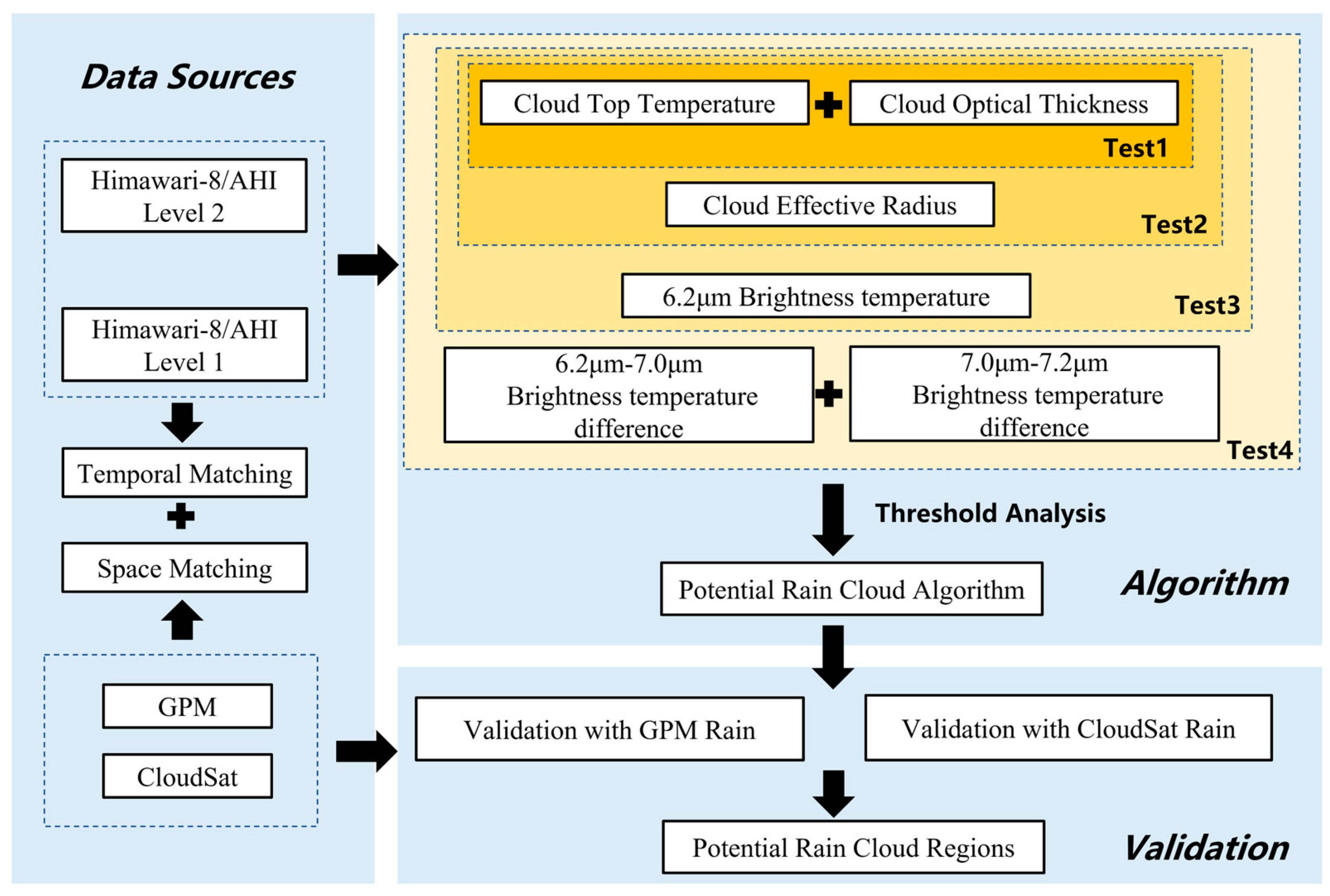
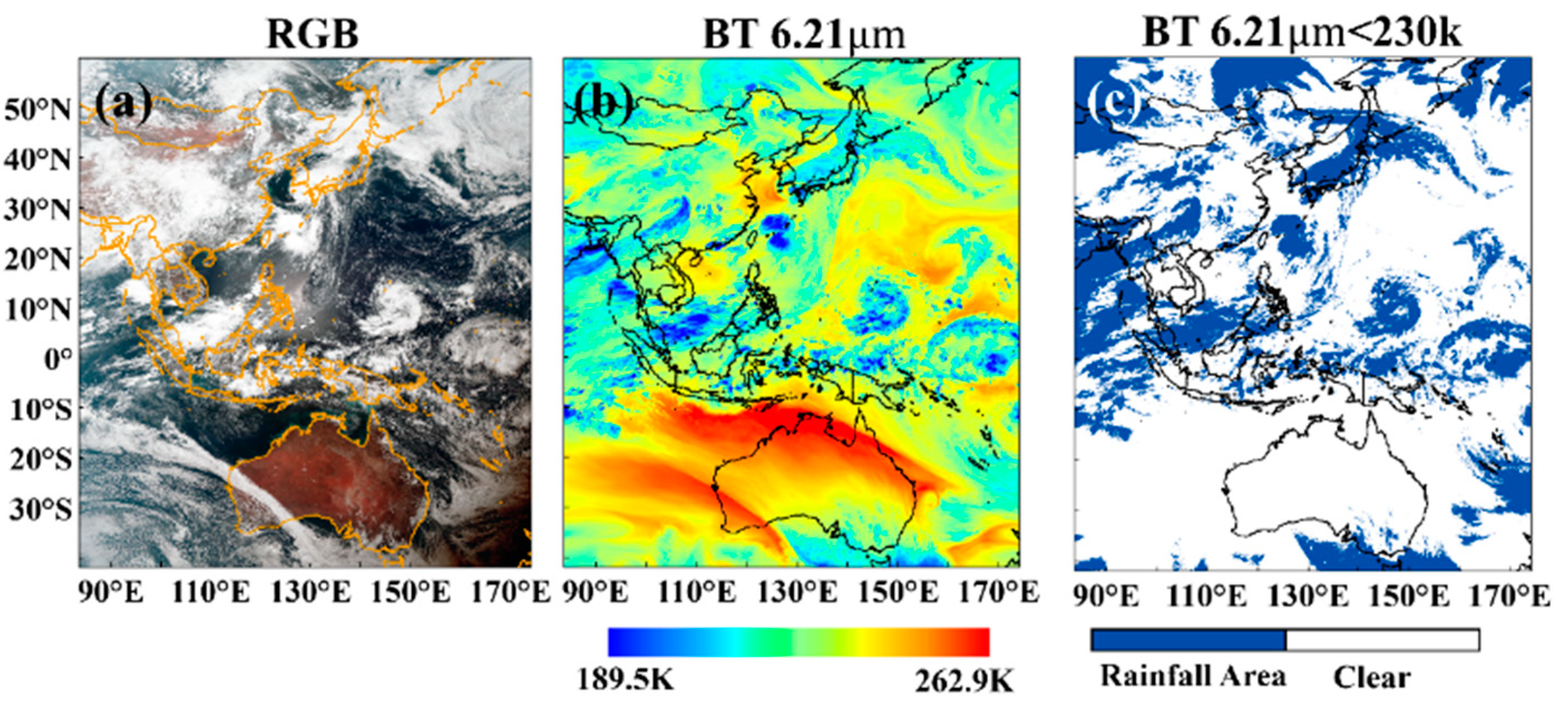

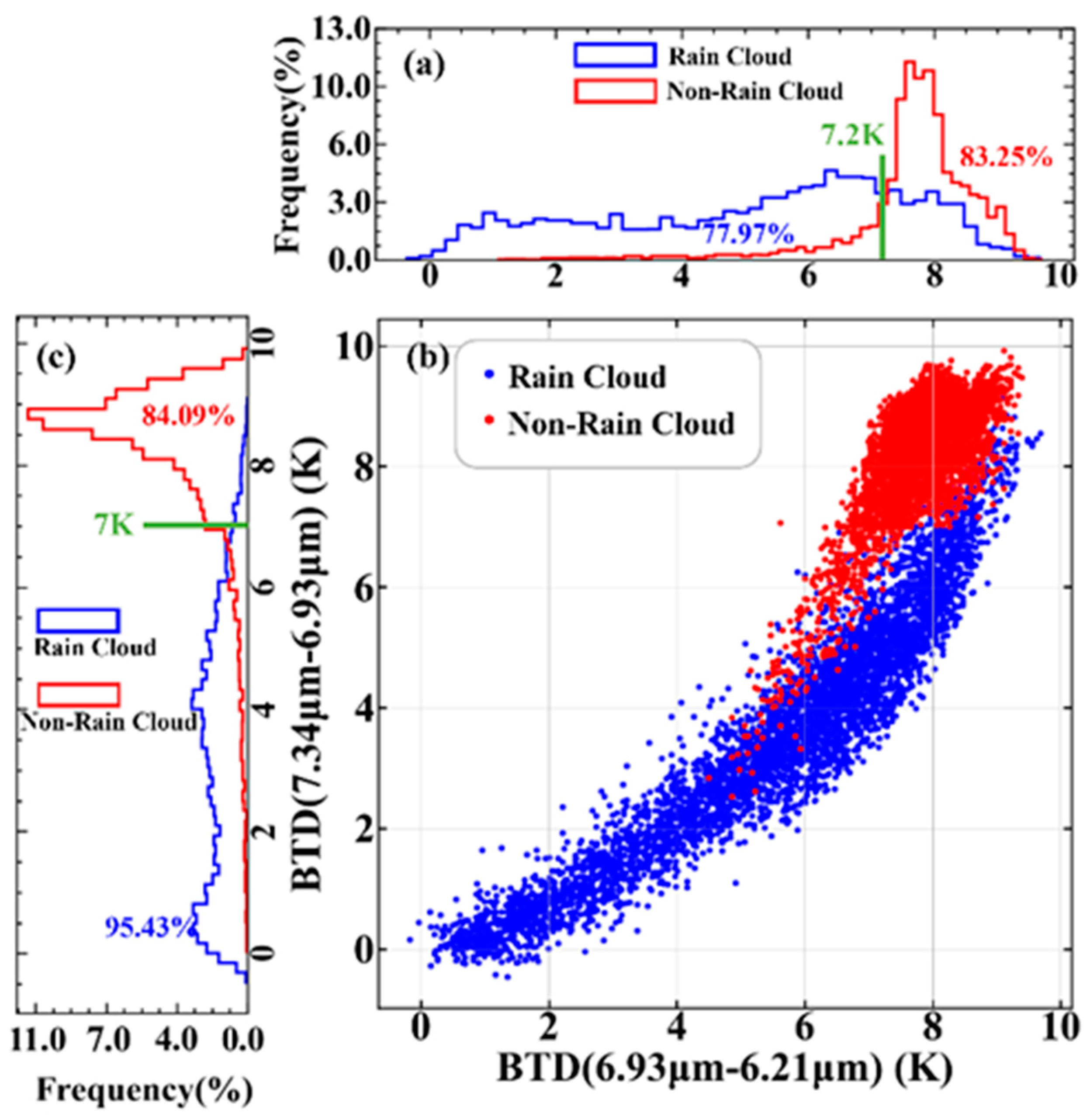
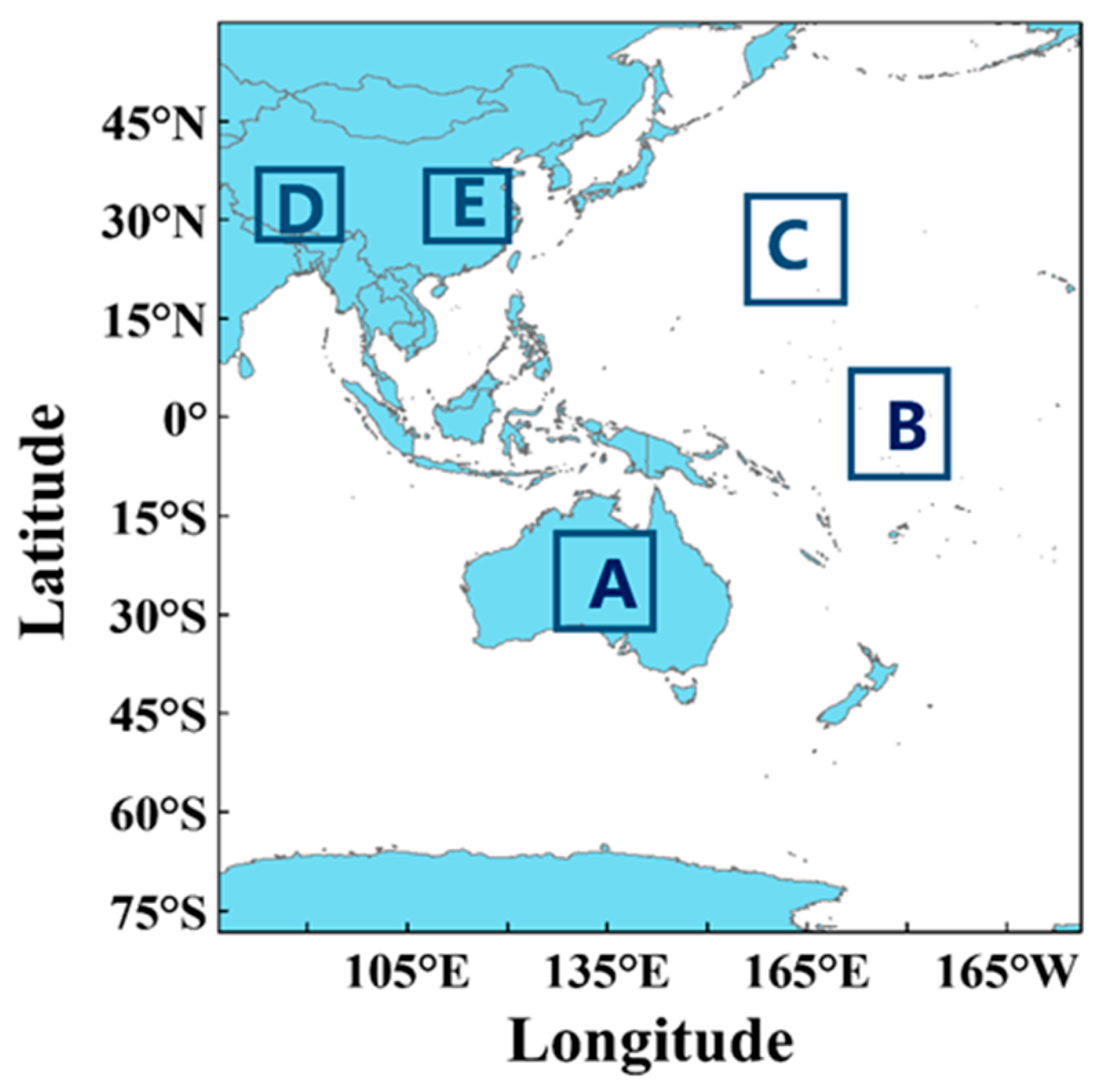
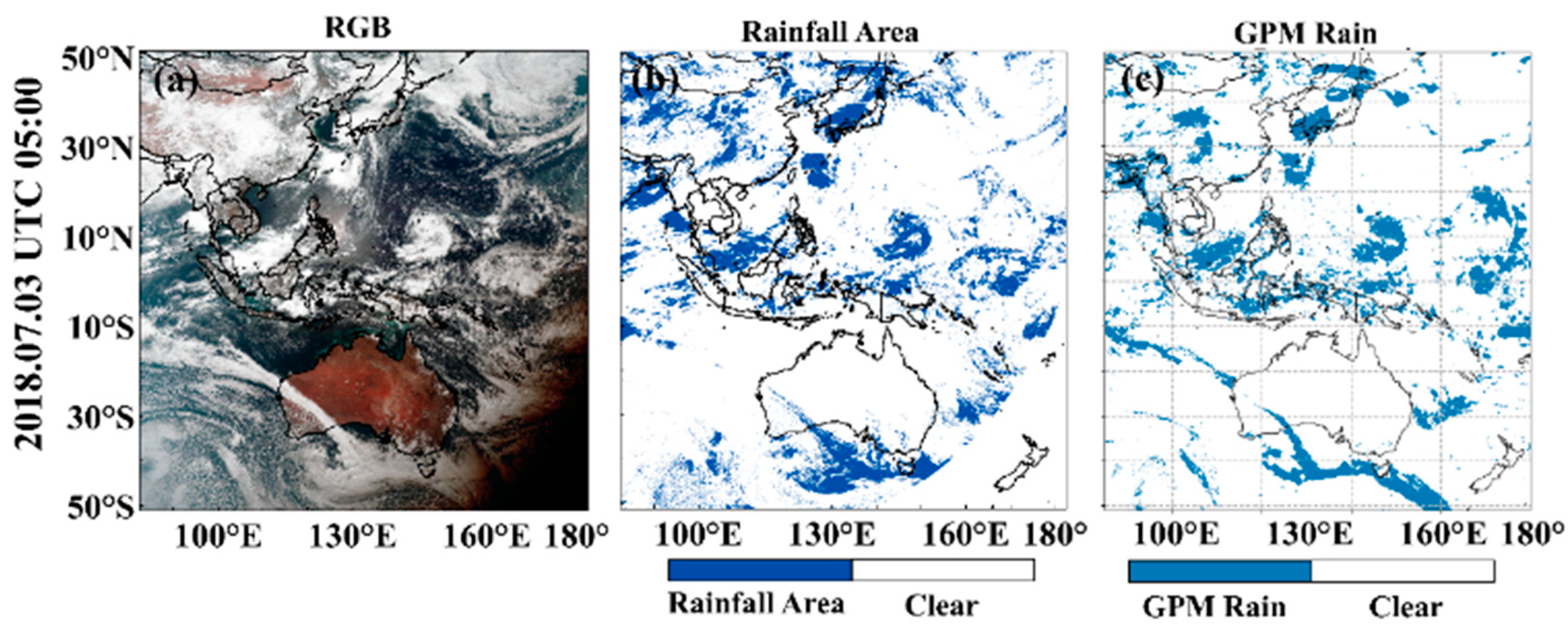
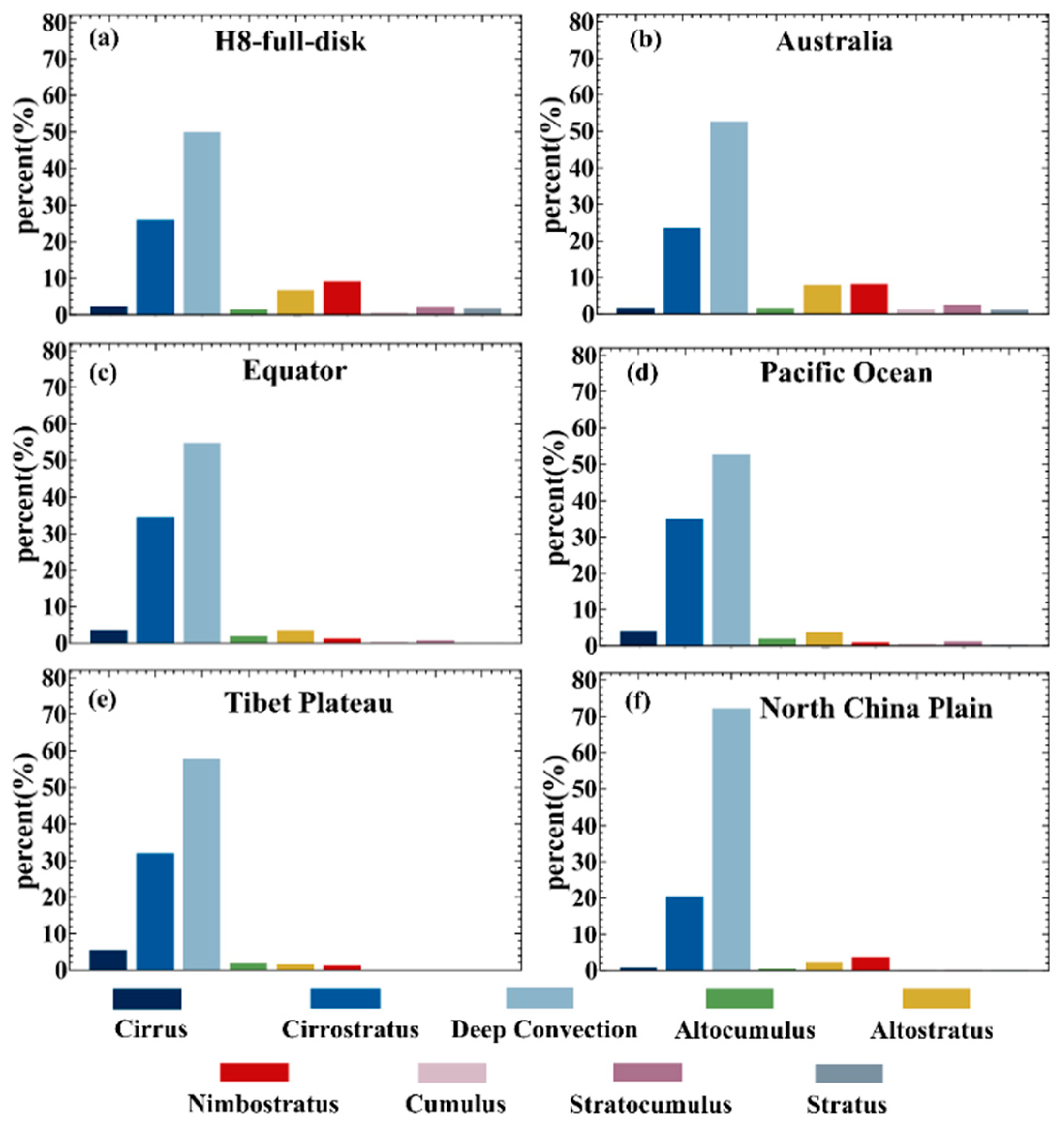

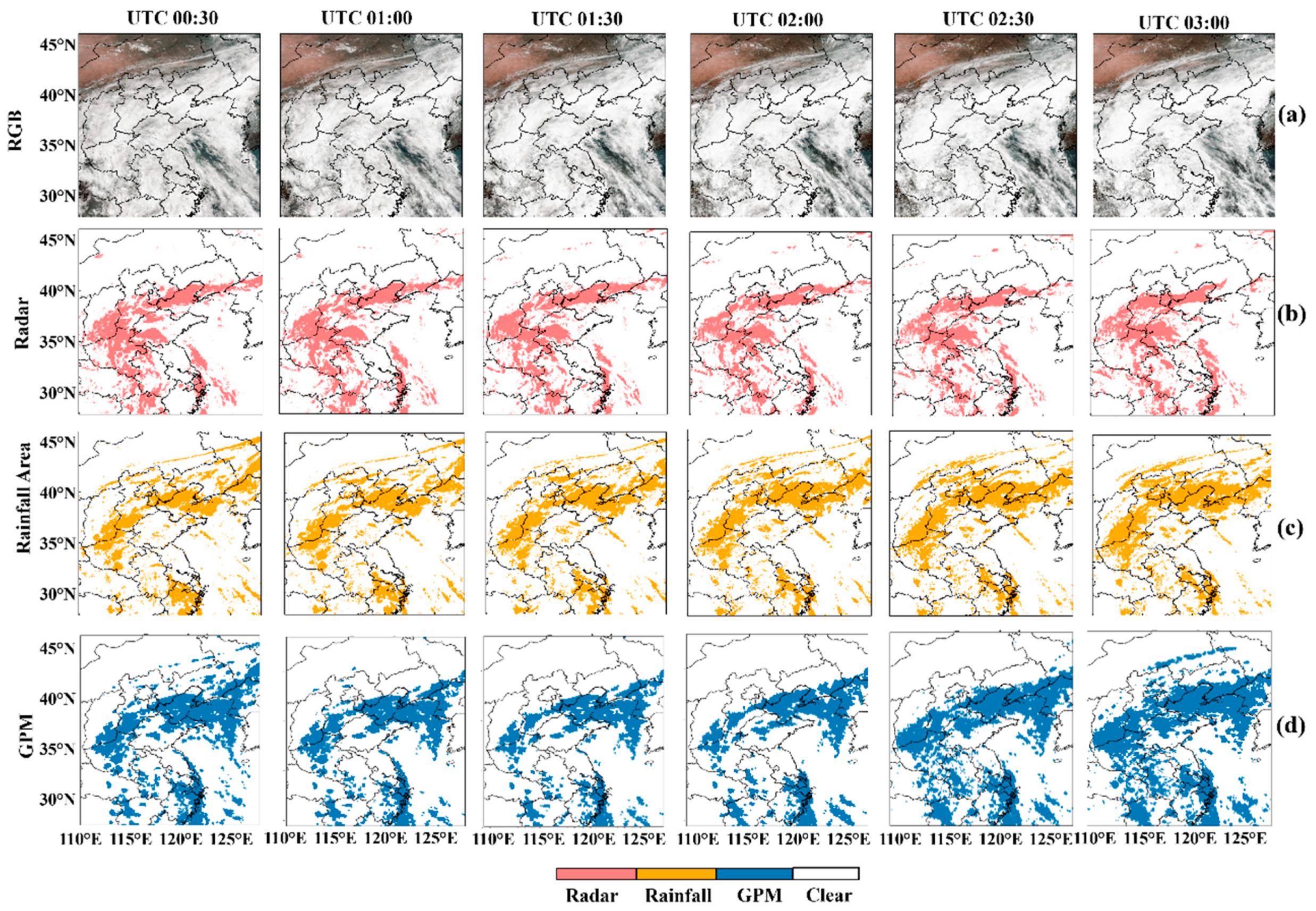
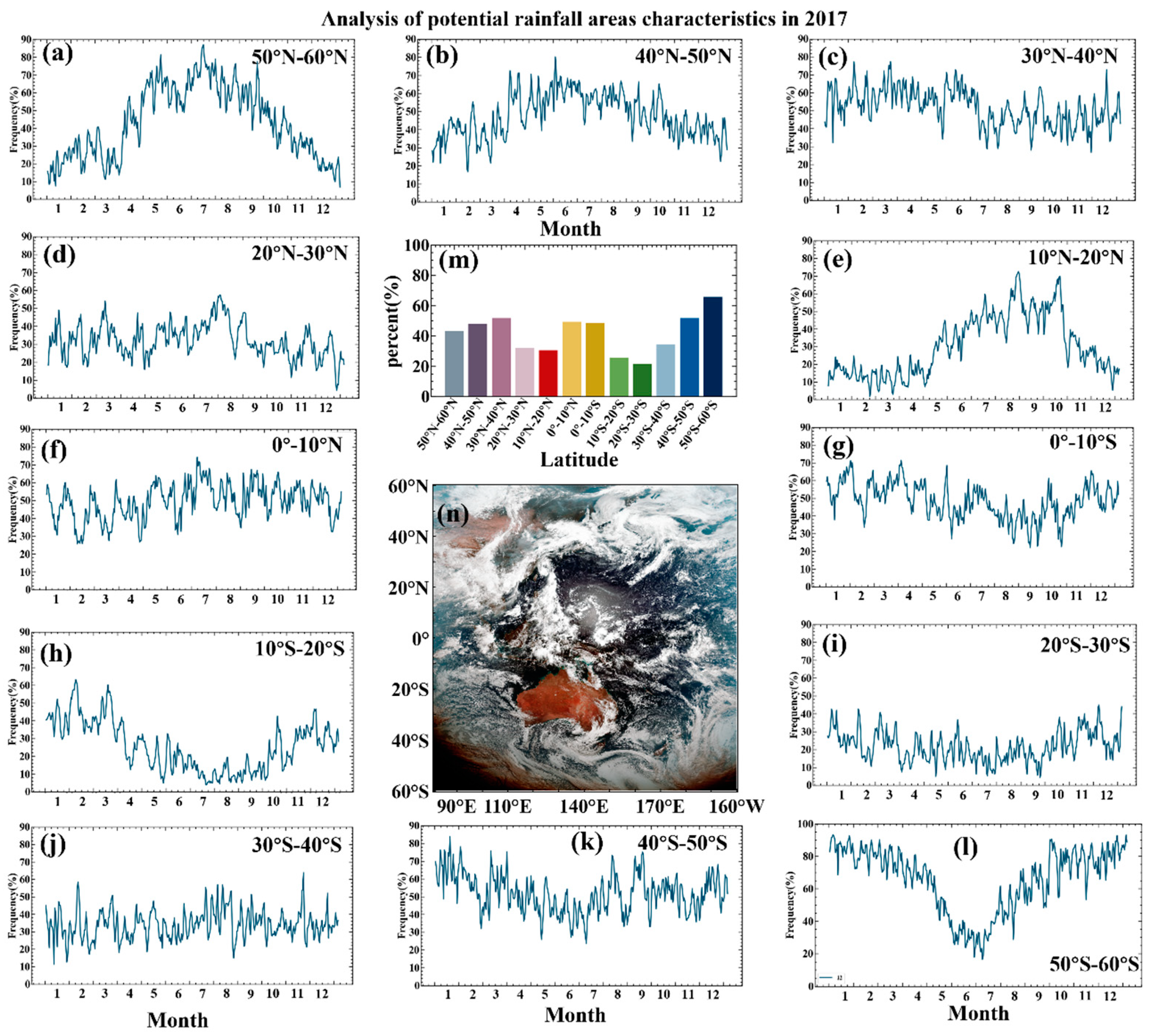
| Properties | Value Change | References |
|---|---|---|
| COT | 10–70 | [21] |
| CTT | 210–265 K | [59] |
| CER | 10–50 μm | [54,56] |
| <235 K | [63] | |
| <7.2 K | ||
| <7 K |
| Test | Properties | ||||
|---|---|---|---|---|---|
| Test1 | COT, CTT COT, CTT, CER COT, CTT, CER, COT, CTT, CER, | ||||
| Test2 | |||||
| Test3 | |||||
| Test4 | |||||
| Ocean | No. of observations | HR (%) | No. of observations | FAR (%) | Accuracy (%) |
| Test1 | 17,011 | 68.83 | 5303 | 2.21 | 84.41 |
| Test2 | 17,011 | 70.86 | 4957 | 2.07 | 85.43 |
| Test3 | 17,011 | 84.95 | 2560 | 11.80 | 86.67 |
| Test4 | 17,011 | 91.68 | 1416 | 11.51 | 89.65 |
| Land | No. of observations | HR (%) | No. of observations | FAR (%) | Accuracy (%) |
| Test1 | 24,832 | 26.32 | 18,297 | 15.25 | 63.16 |
| Test2 | 24,832 | 53.86 | 11,457 | 9.55 | 76.93 |
| Test3 | 24,832 | 61.35 | 9598 | 11.01 | 73.73 |
| Test4 | 24,832 | 63.94 | 8954 | 7.46 | 72.31 |
| H8 full-disk | No. of observations | HR (%) | No. of observations | FAR (%) | Accuracy (%) |
| Test1 | 471,310 | 45.48 | 256,980 | 4.45 | 72.70 |
| Test2 | 471,310 | 61.07 | 183,467 | 3.18 | 80.34 |
| Test3 | 471,310 | 72.20 | 131,021 | 12.04 | 79.54 |
| Test4 | 471,310 | 76.46 | 110,931 | 16.55 | 79.23 |
| Rainfall Area | Non-Rainfall | |||||
|---|---|---|---|---|---|---|
| Period | No. Observation | HR (%) | FAR (%) | HR (%) | FAR (%) | Accuracy (%) |
| 2019.01 | 76,946 | 79.07 | 0.41 | 80.95 | 17.17 | 80.01 |
| 2019.04 | 71,581 | 76.44 | 3.16 | 86.43 | 9.76 | 81.44 |
| 2018.07 | 71,143 | 80.78 | 3.52 | 84.56 | 10.83 | 82.67 |
| 2018.11 | 71,267 | 43.11 | 1.27 | 91.27 | 8.19 | 67.19 |
| total | 290,937 | 70.03 | 2.05 | 85.61 | 11.59 | 77.87 |
| Rainfall Area | Non-Rainfall | |||||
|---|---|---|---|---|---|---|
| Period | No. of Observations | HR (%) | FAR (%) | HR (%) | FAR (%) | Accuracy (%) |
| 2019.01 | 39,561 | 77.93 | 17.98 | 85.59 | 3.82 | 81.13 |
| 2019.04 | 37,670 | 79.87 | 22.10 | 73.46 | 3.50 | 75.09 |
| 2018.07 | 36,552 | 84.45 | 19.43 | 83.34 | 4.21 | 83.51 |
| 2018.11 | 36,972 | 83.60 | 28.51 | 67.33 | 2.19 | 74.30 |
| total | 150,755 | 81.39 | 21.34 | 77.54 | 3.43 | 79.83 |
Disclaimer/Publisher’s Note: The statements, opinions and data contained in all publications are solely those of the individual author(s) and contributor(s) and not of MDPI and/or the editor(s). MDPI and/or the editor(s) disclaim responsibility for any injury to people or property resulting from any ideas, methods, instructions or products referred to in the content. |
© 2024 by the authors. Licensee MDPI, Basel, Switzerland. This article is an open access article distributed under the terms and conditions of the Creative Commons Attribution (CC BY) license (https://creativecommons.org/licenses/by/4.0/).
Share and Cite
Chen, X.; Letu, H.; Shang, H.; Ri, X.; Tang, C.; Ji, D.; Shi, C.; Teng, Y. Rainfall Area Identification Algorithm Based on Himawari-8 Satellite Data and Analysis of its Spatiotemporal Characteristics. Remote Sens. 2024, 16, 747. https://doi.org/10.3390/rs16050747
Chen X, Letu H, Shang H, Ri X, Tang C, Ji D, Shi C, Teng Y. Rainfall Area Identification Algorithm Based on Himawari-8 Satellite Data and Analysis of its Spatiotemporal Characteristics. Remote Sensing. 2024; 16(5):747. https://doi.org/10.3390/rs16050747
Chicago/Turabian StyleChen, Xingru, Husi Letu, Huazhe Shang, Xu Ri, Chenqian Tang, Dabin Ji, Chong Shi, and Yupeng Teng. 2024. "Rainfall Area Identification Algorithm Based on Himawari-8 Satellite Data and Analysis of its Spatiotemporal Characteristics" Remote Sensing 16, no. 5: 747. https://doi.org/10.3390/rs16050747
APA StyleChen, X., Letu, H., Shang, H., Ri, X., Tang, C., Ji, D., Shi, C., & Teng, Y. (2024). Rainfall Area Identification Algorithm Based on Himawari-8 Satellite Data and Analysis of its Spatiotemporal Characteristics. Remote Sensing, 16(5), 747. https://doi.org/10.3390/rs16050747









